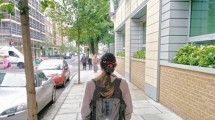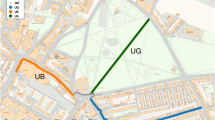Abstract
This study explores the factors contributing to driving pleasure by analyzing multimodal data, including physiological, behavioral, and psychological measures. The Mapper method is used to construct shape graphs, capturing the temporal dynamics of brain activity patterns and their association with driving pleasure. Road geometries are manipulated to investigate their impact on driving pleasure. The results revealed that the difference in road geometry correlated with subjective driving pleasure and was also reflected in the structure of the shape graph. Besides, there were challenges in estimating emotions from facial expressions. The study highlighted the potential of Mapper-based analysis in understanding driving pleasure.


Source-detector distance was set at 30 mm, and the source-SDD distance was at 8 mm






Similar content being viewed by others
Data Availability
The data underlying this article will be shared on reasonable request to the corresponding author.
Abbreviations
- fNIRS:
-
Functional Near-infrared spectroscopy
- PPG:
-
Photoplethysmogram
- HR:
-
Heartrate
- SDD:
-
Short-distance detector
- SSR:
-
Short separation regression
- TDA:
-
Topological data analysis
- TCM:
-
Temporal connectivity matrix
- DyNeuSR:
-
Dynamical neuroimaging spatiotemporal representations
- DBSCAN:
-
Density-based spatial clustering of applications with noise
- DLPFC:
-
Dorsolateral prefrontal cortex
References
Pakusch, C., Stevens, G., Boden, A., Bossauer, P.: Unintended Effects of Autonomous Driving: A Study on Mobility Preferences in the Future. Sustainability 10(7), 2404 (2018). https://doi.org/10.3390/su10072404
Kyriakidis, M., Happee, R., De Winter, J.C.F.: Public opinion on automated driving: Results of an international questionnaire among 5000 respondents. Transport. Res. F: Traffic Psychol. Behav. 32, 127–140 (2015). https://doi.org/10.1016/j.trf.2015.04.014
Frison, A., Wintersberger, P., Riener, A., Schartmüller, C.: Driving Hotzenplotz! A Vehicle Interface that Fosters the Joy of Driving. In Proceedings of the 9th International Conference on Automotive User Interfaces and Interactive Vehicular Applications Adjunct (AutomotiveUI '17), 247–248 (2017). https://doi.org/10.1145/3131726.3131878.
Rödel, C., Stadler, S., Meschtscherjakov, A., & Tscheligi, M.: Towards Autonomous Cars: The Effect of Autonomy Levels on Acceptance and User Experience. In Proceedings of the 6th International Conference on Automotive User Interfaces and Interactive Vehicular Applications (AutomotiveUI '14), 1–8 (2014). https://doi.org/10.1145/2667317.2667330.
Hartwich, F., Beggiato, M., Krems, J.F.: Driving comfort, enjoyment and acceptance of automated driving – effects of drivers’ age and driving style familiarity. Ergonomics 61(8), 1017–1032 (2018). https://doi.org/10.1080/00140139.2018.1441448
Will, S., Metz, B., Hammer, T., Pleß, R., Mörbe, M., Henzler, M., Harnischmacher, F.: Relation between riding pleasure and vehicle dynamics - Results from a motorcycle field test. Appl. Ergon. 90, 103231 (2021). https://doi.org/10.1016/j.apergo.2020.103231
Kang, X., Kim, W., Namgung, M.: Driver Emotional and Perceptual Evaluation over Various Highway Horizontal Curves. KSCE J. Civ. Eng. 24(6), 2201–2213 (2020). https://doi.org/10.1007/s12205-020-1887-z
Weber, M., Giacomin, J., Malizia, A., Skrypchuk, L., Gkatzidou, V., Mouzakitis, A.: Investigation of the dependency of the drivers’ emotional experience on different road types and driving conditions. Transport. Res. F: Traffic Psychol. Behav. 65, 107–120 (2019). https://doi.org/10.1016/j.trf.2019.05.006
Balters, S., Baker, J., Geeseman, J., Reiss, A.: A Methodological Review of fNIRS in Driving Research: Relevance to the Future of Autonomous Vehicles. Front. Human Neurosci. 15, 637589 (2021). https://doi.org/10.3389/fnhum.2021.637589
Yoshino, K., Oka, N., Yamamoto, K., Takahashi, H., Kato, T.: Functional brain imaging using near-infrared spectroscopy during actual driving on an expressway. Front. Hum. Neurosci. 7, 882 (2013). https://doi.org/10.3389/fnhum.2013.00882
Ogihara, T., Tanioka, K., Hiroyasu, T., Hiwa, S.: Predicting the Degree of Distracted Driving Based on fNIRS Functional Connectivity: A Pilot Study. Front. Neuroergon. 3, 864938 (2022). https://doi.org/10.3389/fnrgo.2022.864938
Manelis, A., Huppert, T.J., Rodgers, E., et al.: The role of the right prefrontal cortex in recognition of facial emotional expressions in depressed individuals: fNIRS study. J. Affect Disord. 2019(258), 151–158 (2019). https://doi.org/10.1016/j.jad.2019.08.006
Westgarth, M.M.P., Hogan, C.A., Neumann, D.L., Shum, D.H.K.: A systematic review of studies that used NIRS to measure neural activation during emotion processing in healthy individuals. Soc. Cogn. Affect. Neurosci. 16(4), 345–369 (2021). https://doi.org/10.1093/scan/nsab017
Singh, G., Mémoli, F., Carlsson, G.: Topological Methods for the Analysis of High Dimensional Data Sets and 3D Object Recognition. Eurograph. Symp. Point-Based Graph. 2007, 91–100 (2007). https://doi.org/10.2312/SPBG/SPBG07/091-100
Saggar, M., Sporns, O., Gonzalez-Castillo, J., et al.: Towards a new approach to reveal dynamical organization of the brain using topological data analysis. Nat. Commun. 9, 1399 (2018). https://doi.org/10.1038/s41467-018-03664-4
Geniesse, C., Sporns, O., Petri, G., Saggar, M.: Generating dynamical neuroimaging spatiotemporal representations (DyNeuSR) using topological data analysis. Netw. Neurosci. 3(3), 763–778 (2019). https://doi.org/10.1162/netn_a_00093
Singh, Y., Farrelly, C.M., Hathaway, Q.A., et al.: Topological data analysis in medical imaging: current state of the art. Insights Imaging 14, 58 (2023). https://doi.org/10.1186/s13244-023-01413-w
Assetto Corsa. Available at: https://store.steampowered.com/app/244210/Assetto_Corsa/ (accessed Date: May 23rd, 2023)
Vecchiato, G., Vecchio, M.D., Ascari, L., et al.: Electroencephalographic time-frequency patterns of braking and acceleration movement preparation in car driving simulation. Brain Res. 2019(1716), 16–26 (2019). https://doi.org/10.1016/j.brainres.2018.09.004
Di Liberto, G.M., Barsotti, M., Vecchiato, G., et al.: Robust anticipation of continuous steering actions from electroencephalographic data during simulated driving. Sci. Rep. 11, 23383 (2021). https://doi.org/10.1038/s41598-021-02750-w
Chen, Z., Zheng, Y.X., Hubert, J., et al.: Exploring the use of driving simulation to improve robotic surgery simulator training: an observational case–control study. J. Robotic Surg. (2023). https://doi.org/10.1007/s11701-023-01641-8
Bernstein, J.P.K., Calamia, M., De Vito, A., et al.: Multimethod assessment of driving in older adults using a novel driving simulator. Appl. Neuropsychol. Adult 29(4), 452–461 (2020). https://doi.org/10.1080/23279095.2020.1769098
Bernstein, J., Roye, S., Calamia, M., et al.: Utility of a novel simulator paradigm in the assessment of driving ability in individuals with and without attention-deficit hyperactivity disorder. ADHD Atten. Def. Hyp. Disord. 11, 403–411 (2019). https://doi.org/10.1007/s12402-019-00303-w
de Frutos, S.H., Castro, M.: Assessing sim racing software for low-cost driving simulator to road geometric research. Transp. Res. Procedia 58, 575–582 (2021). https://doi.org/10.1016/j.trpro.2021.11.076
Onate-Vega, D., Oviedo-Trespalacios, O., King, M.: How drivers adapt their behavior to changes in task complexity: The role of secondary task demands and road environment factors. Transport. Res. F: Traffic Psychol. Behav. 71, 145–156 (2020). https://doi.org/10.1016/j.trf.2020.03.015
Zontone, P., Affanni, A., Bernardini, R., et al.: Analysis of Physiological Signals for Stress Recognition with Different Car Handling Setups. Electronics 11, 888 (2022). https://doi.org/10.3390/electronics11060888
Santosa, H., Zhai, X., Fishburn, F., Huppert, T.: The NIRS Brain AnalyzIR Toolbox. Algorithms 11, 73 (2018). https://doi.org/10.3390/a11050073
Yücel, M.A., Selb, J., Aasted, C.M., Petkov, M.P., Becerra, L., Borsook, D., Boas, D.A.: Short separation regression improves statistical significance and better localizes the hemodynamic response obtained by near-infrared spectroscopy for tasks with differing autonomic responses. Neurophotonics 2(3), 035005 (2015). https://doi.org/10.1117/1.NPh.2.3.035005
Pham L., Vu, T.H., Tran. T.A.: Facial Expression Recognition Using Residual Masking Network. In 2020 25th International Conference on Pattern Recognition (ICPR). Milan, Italy 4513–4519 (2021). https://doi.org/10.1109/ICPR48806.2021.9411919.
Zhang, Z., Luo, P., Loy, C.C., et al.: From Facial Expression Recognition to Interpersonal Relation Prediction. Int. J. Comput. Vision 126(5), 550–569 (2018). https://doi.org/10.1007/s11263-017-1055-1
Lucey, P., Cohn, J. F., Kanade, T., Saragih, J., Ambadar, Z., Matthews, I.: The Extended Cohn-Kanade Dataset (CK+): A complete dataset for action unit and emotion-specified expression. In: 2010 IEEE Computer Society Conference on Computer Vision and Pattern Recognition - Workshops, pp. 94–101. IEEE, San Francisco, CA (2010). https://doi.org/10.1109/CVPRW.2010.5543262.
Lyons, M.J.: "Excavating AI" Re-excavated: Debunking a Fallacious Account of the JAFFE Dataset. arXiv preprint (2021). arXiv:2107.13998.
Goodfellow, I.J., et al.: Challenges in Representation Learning: A Report on Three Machine Learning Contests. In M. Lee, A. Hirose, Z.G. Hou, and R.M. Kil (Eds.), Neural Information Processing. ICONIP 2013. Lecture Notes in Computer Science, vol 8228. Springer, Berlin, Heidelberg (2013). https://doi.org/10.1007/978-3-642-42051-1_16.
Wascher, C.A.: Heart rate as a measure of emotional arousal in evolutionary biology. Philos. Trans. R. Soc. B 376, 20200479 (2021). https://doi.org/10.1098/rstb.2020.0479
Newman, M.E., Girvan, M.: Finding and evaluating community structure in networks. Phys. Rev. E 69(2 Pt 2), 026113 (2004). https://doi.org/10.1103/PhysRevE.69.026113
Funding
None to declare.
Author information
Authors and Affiliations
Contributions
SI and SH designed and performed experiments, analyzed data, and wrote the manuscript. KT and TH discussed the results. All authors reviewed the manuscript.
Corresponding author
Ethics declarations
Ethics Approval and Consent to Participate
The study involving human participants was reviewed and approved by the Research Ethics Committee of Doshisha University, Kyoto, Japan (approval code: 23012). The participants provided their written informed consent to participate in this study.
Consent for Publication
The participants provided their written informed consent prior to enrolment in the study.
Competing Interests
The authors declare that the research was conducted in the absence of any commercial or financial relationships that could be construed as potential conflicts of interest.
Additional information
Publisher's Note
Springer Nature remains neutral with regard to jurisdictional claims in published maps and institutional affiliations.
Rights and permissions
Springer Nature or its licensor (e.g. a society or other partner) holds exclusive rights to this article under a publishing agreement with the author(s) or other rightsholder(s); author self-archiving of the accepted manuscript version of this article is solely governed by the terms of such publishing agreement and applicable law.
About this article
Cite this article
Isojima, S., Tanioka, K., Hiroyasu, T. et al. Preliminary Investigation of the Association Between Driving Pleasure and Brain Activity with Mapper-based Topological Data Analysis. Int. J. ITS Res. 21, 424–436 (2023). https://doi.org/10.1007/s13177-023-00371-3
Accepted:
Published:
Issue Date:
DOI: https://doi.org/10.1007/s13177-023-00371-3




